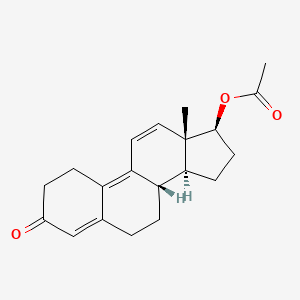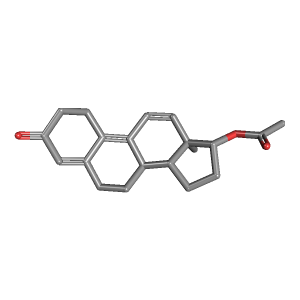Trenbolone Acetate Information
Click here to view all Trenbolone Acetate productsThe information, including but not limited to, text, graphics, images and other material contained on this website are for informational purposes only. No material on this site is intended to be a substitute for the consultation, diagnosis, and/or medical treatment of a qualified physician or healthcare provider.


Trenbolone acetate is a synthetic anabolic steroid that belongs to the class of androgenic-anabolic steroids (AAS). It is derived from the parent hormone nandrolone, with modifications that enhance its anabolic properties. Here are some details about trenbolone acetate:
Anabolic Effects: Trenbolone acetate is highly regarded for its potent anabolic effects. It promotes muscle growth, increases nitrogen retention, and enhances protein synthesis. These effects contribute to significant gains in muscle mass, strength, and athletic performance.
Androgenic Effects: Trenbolone acetate also exhibits strong androgenic properties, which are responsible for the development and maintenance of male sexual characteristics. These effects include deepening of the voice, increased facial and body hair growth, and potential acne.
Esters and Half-Life: Trenbolone acetate is an esterified form of trenbolone. The acetate ester attached to the trenbolone molecule influences its pharmacokinetics and results in a relatively short half-life. Trenbolone acetate has a half-life of approximately 48-72 hours, which requires frequent injections to maintain stable blood levels.
Medical Uses: Trenbolone acetate is not approved for human use in medical settings. It was primarily developed and continues to be used in veterinary medicine to promote muscle growth in livestock.
Performance Enhancement: Trenbolone acetate is widely utilized by athletes and bodybuilders for its remarkable effects on muscle growth, strength, and body composition. It is often incorporated into bulking cycles to maximize mass gains and improve physical performance.
Side Effects: Trenbolone acetate carries the risk of various side effects, which can be dose-dependent and individual-specific. These may include androgenic effects such as oily skin, acne, accelerated hair loss in individuals predisposed to male pattern baldness, and potential virilization in women. Other possible side effects include cardiovascular strain, suppression of natural testosterone production, negative impact on lipid profile, and potential liver toxicity.
Legal Status: The non-medical use of trenbolone acetate is considered illegal and prohibited in most countries. It is classified as a controlled substance due to its potential for abuse and misuse. The laws and regulations surrounding trenbolone acetate and other AAS can vary, so it's important to be aware of and comply with local laws and guidelines.
It is crucial to note that the use of trenbolone acetate or any other AAS should always be approached with caution. Trenbolone acetate is a powerful compound with potential risks and side effects. If you have any specific concerns or considerations regarding trenbolone acetate, it is advisable to consult a healthcare professional or a qualified medical practitioner who can provide personalized advice and guidance.
How Trenbolone Acetate works?
Trenbolone acetate works by binding to androgen receptors in various tissues throughout the body, including muscle cells. Once bound to the androgen receptors, it initiates a series of cellular events that contribute to its anabolic effects. Here's a breakdown of how trenbolone acetate works:
Androgen Receptor Binding: Trenbolone acetate enters the bloodstream after administration and binds to androgen receptors found in target tissues. These receptors are located inside the cells, specifically in the nucleus.
Gene Expression Modulation: The binding of trenbolone acetate to androgen receptors influences gene expression. It activates specific genes responsible for protein synthesis, resulting in increased production of proteins, especially in muscle cells. This process contributes to muscle growth and repair.
Nitrogen Retention: Trenbolone acetate enhances nitrogen retention in the muscle tissue. Nitrogen is an essential component of protein molecules, and a positive nitrogen balance promotes anabolism (muscle growth) by ensuring that the body remains in a state of protein synthesis rather than protein breakdown. Increased nitrogen retention leads to an improved muscle-building environment.
Protein Synthesis: Trenbolone acetate stimulates protein synthesis in muscle cells. Protein synthesis is the process by which cells build new proteins, including muscle proteins. By enhancing protein synthesis, trenbolone acetate promotes muscle tissue growth and repair, leading to increased muscle mass and strength.
Inhibition of Glucocorticoids: Trenbolone acetate has anti-catabolic properties, meaning it inhibits the actions of glucocorticoid hormones. Glucocorticoids are stress hormones that can promote muscle breakdown and hinder muscle growth. By inhibiting glucocorticoid activity, trenbolone acetate helps to preserve muscle tissue and prevent catabolism.
Increased Red Blood Cell Production: Trenbolone acetate can stimulate the production of red blood cells (erythropoiesis). This can enhance oxygen-carrying capacity, leading to improved endurance and stamina during physical activities.
It's important to note that while trenbolone acetate has potent anabolic effects, it also carries the risk of potential side effects. These can include androgenic effects, cardiovascular strain, suppression of natural testosterone production, and potential liver toxicity, among others. The use of trenbolone acetate should always be approached with caution, and it is advisable to consult a healthcare professional or a qualified medical practitioner before using this compound.
Synonyms of Trenbolone Acetate
- Trenbolone acetate
- 10161-34-9
- Finaplix
- Trenbolone 17-acetate
- Trienbolone acetate
- Component T-S
- Trenbolone (acetate)
- RU-1697
- Finaplix H
- Finaplix-S
- Component T-H
- Trenbolone acetate [USAN]
- [(8S,13S,14S,17S)-13-methyl-3-oxo-2,6,7,8,14,15,16,17-octahydro-1H-cyclopenta[a]phenanthren-17-yl] acetate
- Trenbolone acetate ciii
- EINECS 233-432-5
- UNII-RUD5Y4SV0S
- RUD5Y4SV0S
- 17-beta-(Acetyloxy)estra-4,9,11-trien-3-one
- RU 1697
- 17beta-Hydroxyestra-4,9,11-trien-3-one, acetate
- BRN 2012395
- 3-Oxo-17beta-acetoxyestra-4,9,11-triene
- Trenbolone acetate [USAN:USP]
- DTXSID2046626
- 17-beta-Acetoxy-delta-4,9,11-estratrien-3-one
- 17-beta-Hydroxyestra-4,9,11-trien-3-one acetate
- 17beta-Hydroxyestra-4,9,11-trien-3-one 17-acetate
- Estra-4,9,11-trien-3-one, 17-(acetyloxy)-, (17b)-
- NCGC00167439-01
- Estra-4,9,11-trien-3-one, 17-beta-hydroxy-, acetate
- Estra-4,9,11-trien-3-one, 17-(acetyloxy)-, (17beta)-
- Estra-4,9,11-trien-3-one, 17-(acetyloxy)-, (17.beta.)-
- Trenbolone-acetate
- Finaplix (TN)
- trenbolone acetate, (17beta)-isomer
- REVALOR-H
- Trenbolone 17|A-acetate
- Trenbolone acetate (USP)
- ru1697
- SCHEMBL139877
- TRENBOLONE ACETATE [MI]
- CHEMBL1698011
- DTXCID0026626
- CHEBI:192671
- TRENBOLONE ACETATE [MART.]
- BCP11574
- TRENBOLONE ACETATE [WHO-DD]
- Tox21_112443
- BDBM50190646
- s4795
- AKOS015895158
- CCG-267604
- CS-3362
- DB14660
- DS-8264
- TRENBOLONE ACETATE [GREEN BOOK]
- NCGC00167439-03
- TRENBOLONE ACETATE [USP IMPURITY]
- TRENBOLONE ACETATE CIII [USP-RS]
- HY-12360
- LS-64823
- TRENBOLONE ACETATE [USP MONOGRAPH]
- CAS-10161-34-9
- D06211
- Q27288295
- Estra-4,9,11-trien-3-one, 17-(acetyloxy)-, (17-beta)-
- Trenbolone-acetate. Short expiry date due to chemical nature of component(s)
- (8S,13S,14S,17S)-13-methyl-3-oxo-2,3,6,7,8,13,14,15,16,17-decahydro-1H-cyclopenta[a]phenanthren-17-yl acetate

